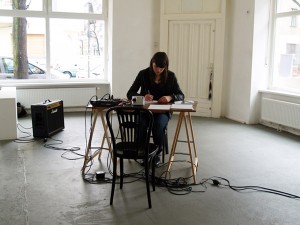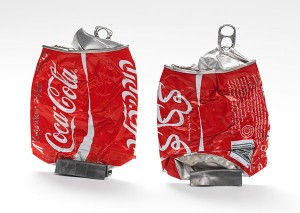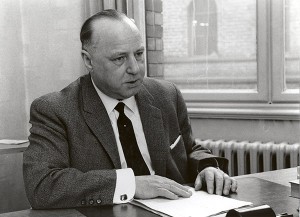An Interview with Alex Martinis Roe

Alex Martinis Roe, Encounters: Conversation in Practice, performance still, 2010.
Image courtesy of the artist.
To obtain a letter from a vending machine – even from an art vending machine – is rather unusual. In this interview, Australian artist Alex Martinis Roe explains what motivated her to create the artwork “A Letter to Deutsche Post.”
Christiane Bauer: Alex, you drafted a letter to Deutsche Post, asking the officers to reissue stamps depicting Rahel Varnhagen and Hannah Arendt. When our visitors purchase the letter, are they supposed to send it to Deutsche Post?
Alex Martinis Roe: I don’t expect visitors to send the letter to Deutsche Post, because I didn’t ask them to. They can do whatever they like with it. If they send it off, I’m happy. If they keep it, I’m also happy. (laughs) What I hope, is that they read the letter and become interested in the story.
Why did you choose to make a letter for the art vending machine? → continue reading
A Conversation with Andrei Krioukov

Artistically-treated Coca-cola cans
© Jewish Museum Berlin, photo: Jens Ziehe
As a contribution to our art vending machine, Andrei Krioukov treated and crushed Coca-Cola cans with Hebrew and Arabic labels. I met him and his wife Rita at their art school on Immanuelkirchstraße in Berlin. This is where Andrei teaches international students, who both study and take their state-recognized exams with him.
In our discussion Andrei talks about his fascination with the design of the famous cans and explains the elements of both trash and art they represent.
Christiane Bauer: Andrei, what fascinates you about the Coca-Cola can?
Andrei Krioukov: These cans are typical of our lives today. You can find them everywhere, but hardly anyone notices them. For me, the discrepancy between art and trash is an exciting subject: if a can is lying on the street, it’s trash. But if I pick it up and contemplate it, and I ponder what I can do with it, it turns into art.
An artist from the 19th century could paint garlic, an onion, or a pitcher of water. Today our lives are full of Coca-Cola cans.
The pitcher appeared in still life paintings as an object from everyday life. What significance does the can have? Do you see a can of Coke as a disposable article or as a modern cultural artifact? → continue reading
… the Auschwitz Trial Began 50 Years Ago Today
On 20 December 1963, Federal Germany’s largest and longest-lasting trial to date of crimes committed in National Socialist concentration and extermination camps opened in the council chamber of Frankfurt’s Römer, the city hall. On trial were twenty-two former staff members who had worked between 1941 and 1945 at the Auschwitz concentration camp. The highest-ranking defendant and last commandant of the camp, Richard Baer, had died just before the trial began. Many others did not face charges at all, not least because almost all crimes dating from the Nazi era were already time-barred—even homicide.

Hans Hofmeyer
© Schindler‐Foto‐Report
Since the Federal German legislature had not anchored the Allies’ postwar trials in Federal German law, trial proceedings in Frankfurt am Main—and likewise all subsequent trials of Nazi crimes—were based on the Penal Code of 1871. Consequently the only charges made were those of murder, and of aiding and abetting murder; and the court, under the guidance of the presiding judge Hans Hofmeyer, was accordingly obliged to find whether defendants had been personally involved in acts of murder, that is to say, had broken the law. → continue reading


